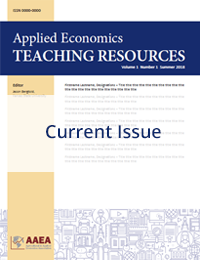Research Article
Following Along or Falling Behind? An Analysis of Internet Access During Lab-Based University Classes
Timothy Delbridge(a), and Xiaowei Cai(a)
(a)California Polytechnic State University
JEL Codes: A2
Keywords: Computer labs, distraction, undergraduate teaching
First Published Online: September 24, 2020
Volume 2, Issue 4
Abstract
Most undergraduate programs in agribusiness and applied economics include courses on data analysis, spreadsheet modeling, and other topics that are inherently computer-based. It is typical in these courses for students to have access to computers either during lecture or in lab sessions. In fact, students in some agribusiness and applied economics programs may spend a majority of their total in-class time with access to their own laptop or a desktop computer in a university lab. In this context it becomes crucially important for educators to understand how students consume and interact with course materials, including spoken lectures, while they simultaneously engage with technology. Previous research on the use of computers in the classroom show that there exists the potential for technology access to help students follow along and strengthen their understanding of course concepts during a lecture, but also that there is a risk that students are distracted by the available technology and end up falling behind. This study analyzes the effect of restricted internet access during lab-based class meetings on student learning outcomes, and provides guidance on instructor policies around technology use in the classroom.
References
Downs, E., A. Tran, R. McMenemy, and N. Abegaze. 2015. “Exam Performance and Attitudes Toward Multitasking in Six, Multimedia-Multitasking Classrooms Environments.” Computers and Education 86:250–259. https://doi.org/10.1016/j.compedu.2015.08.008
Elliott-Dorans, L.R. 2018. “To Ban or Not to Ban? The Effect of Permissive versus Restrictive Laptop Policies on Student Outcomes and Teaching Evaluations.” Computers and Education 126(July):183–200. https://doi.org/10.1016/j.compedu.2018.07.008
Farley, J., E.F. Risco, and A. Kingston. 2013. “Everyday Attention and Lecture Retention: The Effects of Time, Fidgeting, and Mind Wandering.” Frontiers in Psychology 18. https://doi.org/10.3389/fpsyg.2013.00619
Fried, C.B. 2008. “In-class Laptop Use and Its Effects on Student Learning.” Computers and Education 50(3):906–914. https://doi.org/10.1016/j.compedu.2006.09.006
Hembrooke, H., and G. Gay. 2003. “The Laptop and the Lecture: The Effects of Multitasking in Learning Environments.” Journal of Computing in Higher Education 15(1):46–64. https://doi.org/10.1007/BF02940852
Kraushaar, J. M., and D.C. Novak. 2006. “Examining the Affects of Student Multitasking with Laptops During the Lecture.” Journal of Information Systems Education 21(2):241–252.
May, K.E., and A.D. Elder. 2018. “Efficient, Helpful, or Distracting? A Literature Review of Media Multitasking in Relation to
Academic Performance.” International Journal of Educational Technology in Higher Education 15(13). https://doi.org/10.118/s41239-018-0096-z
Sana, F., T. Weston, and N.J. Cepeda. 2013. “Laptop Multitasking Hinders Classroom Learning for Both Users and Nearby Peers.” Computers and Education 62:24–31. https://doi.org/10.1016/j.compedu.2012.10.003
Vahedi, Z., L. Zannella, and S.C. Want. 2019. “Students’ Use of Information and Communication Technologies in the Classroom: Uses, Restriction, and Integration.” Active Learning in Higher Education:1–14. https://doi.org/10.1177/1469787419861926
Wurst, C., C. Smarkola, and M.A. Gaffney. 2008. “Ubiquitous Laptop Usage in Higher Education: Effects on Student Achievement, Student Satisfaction, and Constructivist Measures in Honors and Traditional Classrooms.” Computers and Education 51(4):1766–1783. https://doi.org/10.1016/j.compedu.2008.05.006
Zhang, W. 2015. “Learning Variables, In-Class Laptop Multitasking and Academic Performance: A Path Analysis.” Computer and Education 81:82–88. https://doi.org/10.1016/j.compedu.2014.09.012
Articles in this issue
Following Along or Falling Behind? An Analysis of Internet Access During Lab-Based University Classes
Timothy Delbridge, and Xiaowei Cai
Developing R Shiny Web Applications for Extension Education
A Fire Sale for an Incombustible Commodity: Entry and Exit in the Helium Market
Katherine Lacy, Elliott Parker, Olga Shapoval, and Todd Sørensen
Capital Budgeting Analysis of a Vertically Integrated Egg Firm: Conventional and Cage-Free Egg Production
Carlos J.O. Trejo-Pech and Susan White
A Commentary on Extension Education Programming: An Overview of the CattleTrace Extension Program and Graduate Extension Education
Hannah E. Shear
Curating Campus Support Resources to Provide Easy Access for All Students
Kristin Kiesel, Bwalya Lungu, and Mark Wilson


